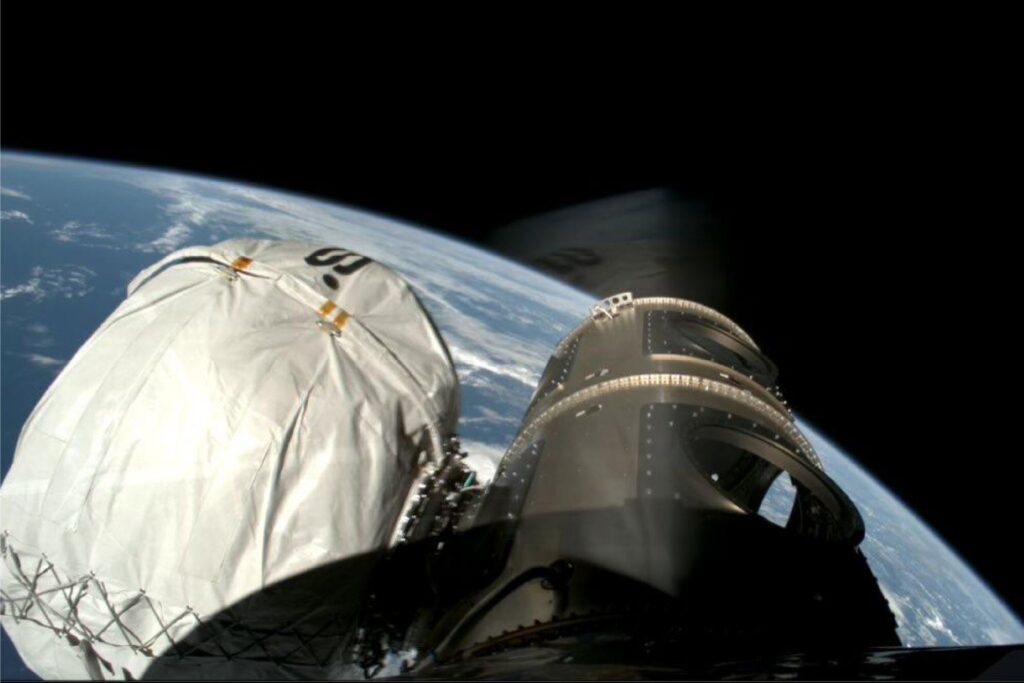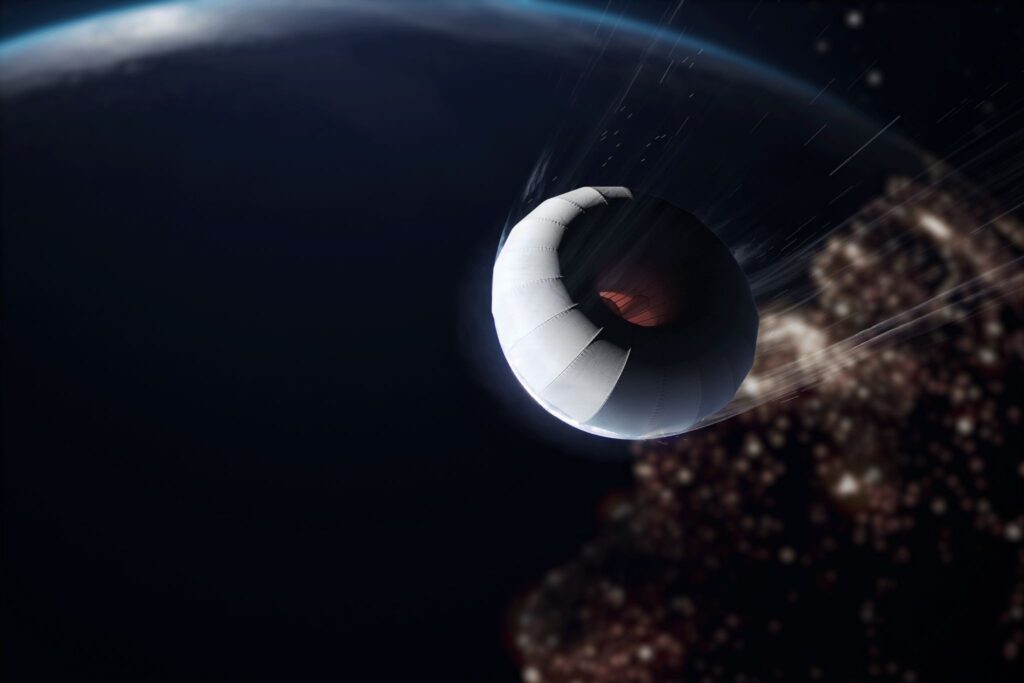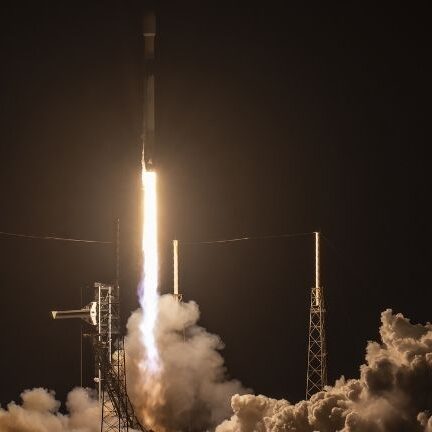- ATMOS Space Cargo meets critical mission objectives during first flight of its PHOENIX 1 prototype, launched as part of SpaceX’s Bandwagon-3 mission.
- ATMOS tested its innovative Inflatable Heat Shield technology early under realistic flight conditions, as part if its rapid prototyping approach.
- This mission marks a significant step forward to efficient and sovereign European return capacities.
- PHOENIX 2 development is underway, with a test flight planned for 2026.
Lichtenau, Germany – April 23, 2025 – ATMOS Space Cargo (ATMOS), a leading European space logistics startup has conducted the first orbital test flight of its innovative PHOENIX 1 re-entry capsule to and back from Low Earth Orbit (LEO).
Initial analysis confirms that the mission achieved its primary objectives, including the activation of key systems and deployment of ATMOS’ proprietary inflatable heat shield under realistic re-entry conditions.
ATMOS Mission Control in Lichtenau adds that expected flight data from the capsule and its onboard customer payloads has been successfully transmitted and is currently undergoing detailed analysis.
These findings add critical information early to the already started development of the next-generation PHOENIX 2 capsule, which is planned to launch in 2026.
A European Milestone in Re-Entry Technology
This flight establishes ATMOS as the fastest-moving private space logistics company in Europe to conduct an orbital return mission. It also demonstrates that sovereign return capabilities are within reach – and that private industry is ready to lead in building Europe’s independent space infrastructure.

PHOENIX 1 in orbit
“PHOENIX 1 delivered on its objectives and our roadmap. Dedicated people show up, go to work and get results – we are not here to guess. Completing this mission with a flight-ready capsule in such a short time frame is a major validation of our design and approach under real conditions,” said Sebastian Klaus, CEO and Co-Founder of ATMOS.
“As a side effect it gave proof that we are able to conduct a multinational operation to create a valuable and inspiring outcome across the entire team and beyond. We’re on track to build PHOENIX 2 – a next gen capsule capable of setting its own return trajectory, unlocking the most flexible, cost-efficient and reliable end-to-end space logistics platform in the space industry.”
Mission Summary
Launch & De-Orbit Maneuver
PHOENIX 1 launched into space aboard a SpaceX Falcon 9 rocket from Launch Complex 40 (SLC-40), Cape Canaveral Space Force Station, Florida at 20:48 local time, as part of the Bandwagon-3 rideshare mission.
Following injection into a 45° inclination orbit, the capsule completed one full orbit.
A planned de-orbit burn by the Falcon 9 upper stage over Los Angeles, California, then placed PHOENIX 1 on its return trajectory.

Rendering of PHOENIX 1 re-entry
Re-entry & Data Recovery
Following upper stage separation, PHOENIX 1 began its return trajectory, transmitting critical system and payload data to ground stations the ATMOS ground segment team set up across South America.
As planned, the capsule performed initial inflation of its heat shield before ****entering Earth’s atmosphere at the Entry Interface Point (EIP) approximately two hours post-launch south-east of the Brazilian coast.
Due to a recent trajectory update and extended splashdown distance (~2,000 km off the coast), recovery was not planned – effected by the increased distance from available marine infrastructure.
ATMOS’ current roadmap for PHOENIX 2 confirms to feature its own propulsion system, enabling the capsule to choose its re-entry trajectory and splashdown zone, enabling swift recovery.
Key First Flight Mission Objectives:
While a thorough data and mission analysis is being conducted these coming days, ATMOS confirms that PHOENIX 1’s planned mission objectives were met:
Mission Objective 01: Collecting in-flight data from the capsule and sub-components in orbit.
Mission Objective 02: Gathering scientific data from customer payloads carrying technology demonstrators and biological experiments.
Mission Objective 03: Deploying the Inflatable Heat Shield before atmospheric re-entry.
Although data from the final stage of descent could not be retrieved, the data sent by PHOENIX and received by our recently set up ground stations completes significant learnings from conducting a test mission with a flight-ready prototype at an early stage adding to the list of instrumental objectives.
ATMOS will share further mission details upon completion of data analysis.
“We designed PHOENIX 1 to move fast without compromising core reliability, fundamental for any spacecraft. Thanks to the experience and fast problem solving skill set our team brings to the workshop, we achieved flight qualification in record time. Building and launching a space-ready capsule in under a year required tight iteration and testing, good communication, and a team spirit beyond expectations. This flight – and the engineering process that led us here – taught us valuable lessons on the design of the next iteration, PHOENIX 2” says Christian Grimm, Lead Systems Engineer and Co-Founder at ATMOS Space Cargo.
Mission and Technology Milestones
Developed and qualified for flight in under 12 months, PHOENIX 1’s mission is an integral element to ATMOS’ rapid prototyping approach and the company’s novel Inflatable Heat Shield – a technology designed to allow the return of payload from space – without traditional ablative materials or parachutes.
On its first mission, PHOENIX 1 was also carrying commercial and scientific payloads for early-stage microgravity testing, including biological experiments and technological demonstrators from:
- Frontier Space & Imperial College London – UK
- DLR German Aerospace Center
- IDDK – Japan
As per ATMOS’s product roadmap, future iterations of the capsule are already in development to support multi-tonne orbital supplies and dual-use payloads.
Additional important outcomes of this protoflight were:
- Qualification of the capsule and its subsystems for orbital environments
- Full integration readiness of the PHOENIX system with a Falcon 9 launch vehicle
- End-to-end validation of the ground control, telemetry, and data acquisition architecture
- Successful operational execution and training of all teams under real mission conditions
“PHOENIX 1 wasn’t just a tech demo – it was also a commercial mission that required us to deliver outcomes. The fact that we delivered data from Low Earth Orbit to our payload partners in biotech and advanced materials, underlines the value of what we are building: We are not just solving re-entry – we are enabling new industries to work in space and create benefit on Earth.” –
Marta Oliveira, Chief Operating Officer and Co-Founder of ATMOS.
PHOENIX re-entry technology & future roadmap
ATMOS remains on track for its next development milestones and planned series of orbital flights, which will ultimately shape the future of commercial re-entry systems in Europe.
With a payload efficiency of 1:2, PHOENIX already offers the highest mass efficiency on the market, opening new growth opportunities in microgravity research, in-space manufacturing, and biotechnology.
Its next-generation capsule platform for returning cargo from space will support both commercial and institutional missions while strengthening core public domains and sovereign infrastructure development in Europe – including for Europe’s defense sector.
“Technological innovation in space does not exist without flight data. As we are building something new here – most data that supports our technology – must come from us.
If the science aint written yet, you gotta go out there and write it.” – “Space Jeff” Hendrikse, Chief Technological Officer and Co-founder of ATMOS.
Amadeus Capital Partners invested in ATMOS Space Cargo through the Amadeus APEX Technology Fund.

